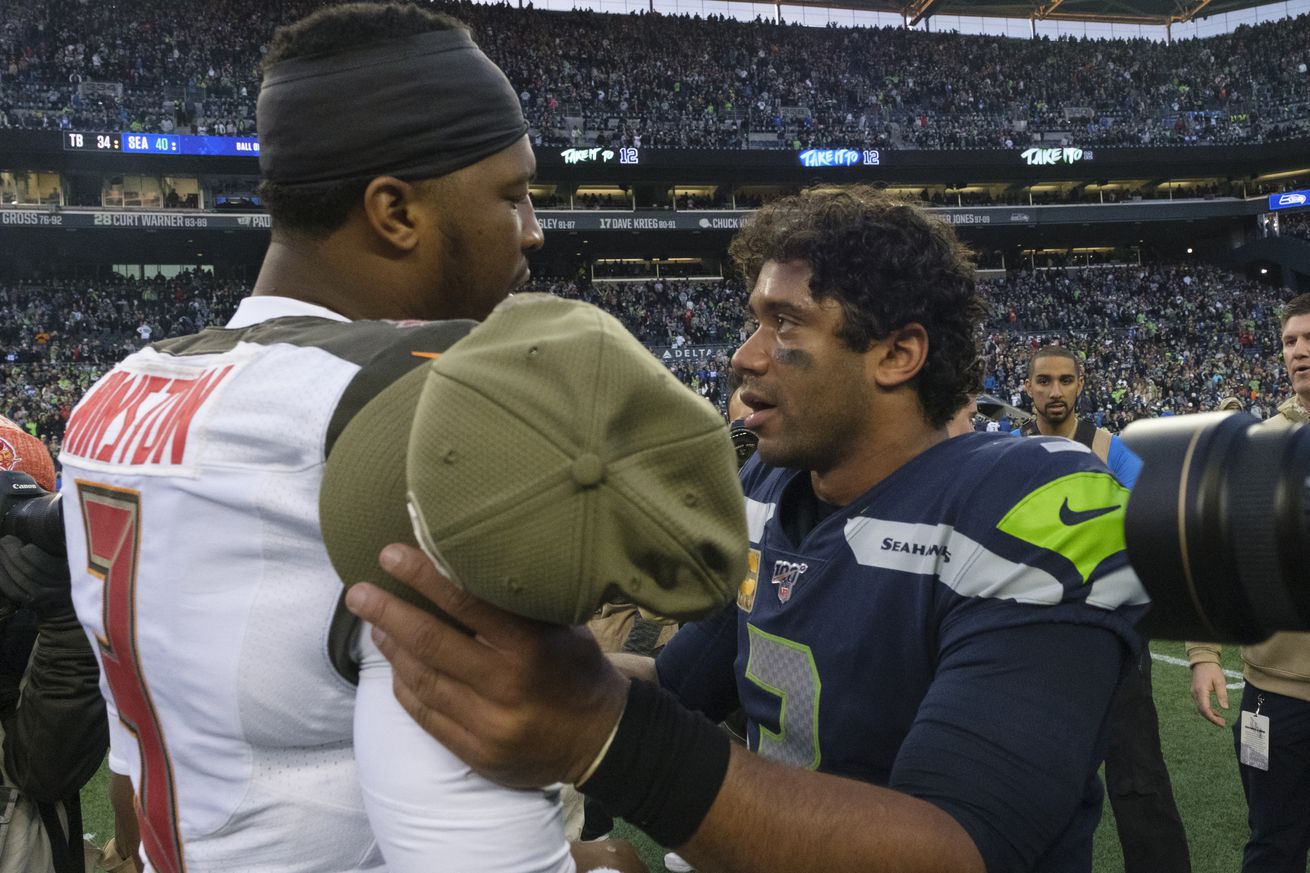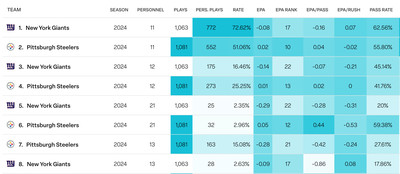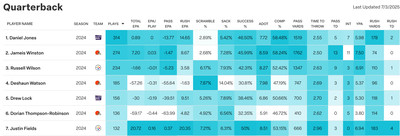
And will his move to the Giants help him?
There is a wide variety of opinions about whether the New York Giants are poised to show tangible improvement this season or experience the latest in a decade-plus full of disappointments. There are many facets to this question (22 in fact, not even counting special teams), but we all know that quarterback play leads the list.
Let’s leave Jaxson Dart out of this discussion – no one knows how long it will be before Brian Daboll sees him as being NFL-ready, and there is no way to project his NFL success or lack thereof. The other two quarterbacks, Russell Wilson and Jameis Winston, do have a track record, and we can look at it, especially last season’s, to understand a bit better who they are at this stage of their careers. Wilson is the expected starter but it won’t be a shock if Winston sees snaps this year.
For this purpose, I’m going to utilize the Sumer Sports player statistics database. One cannot isolate specific players, so creative sorting is required, and it doesn’t always work perfectly. Its attractiveness, though (other than part of it not being behind a paywall), is that it breaks down quarterback stats situationally in many different ways, allowing us to get a better feel for each QB.
First, let’s look at the basic stats. Specifically, we’ll compare 2024 Wilson and Winston to 2024 Daniel Jones. All three quarterbacks started for roughly half the season, so their sample sizes aren’t all that different:

Courtesy of Sumer Sports
Expected points added (EPA) per play is considered by many to be the best overall metric of quarterback play. For reference, the NFL leaders in EPA per play in 2024 were Josh Allen (0.31) and Lamar Jackson (0.28). All three former and present Giants’ QBs had similar, slightly negative EPA per play, i.e., they all had an approximately neutral effect on their team’s point scoring but slightly hindered it. Not much of an endorsement for 2025.
Looking further at total EPA separated by passing and rushing (scrambles + designed runs), we see that Wilson hurt his team a little more when he took off with the ball (-7.59) than when he passed it (-3.71). This is the narrative on Wilson – stubbornly looking for the big play and taking negative plays when he might have found a shallow target. Winston on the other hand was a lot like Daniel Jones: Both used their legs to positive effect but cost their teams dearly when throwing the ball – Winston by offsetting a decent number of touchdown passes with almost as many interceptions, and Jones, with only a modest number of INTs but an almost equally modest number of TDs.
Dependence on personnel grouping
Of course, quarterback play isn’t independent of the rest of the offense and the coaches. Nick Falato had a great analysis of how it affects Russell Wilson. Pittsburgh last year threw primarily to George Pickens and Calvin Austin, while Cleveland’s main targets were Jerry Jeudy and Elijah Moore. I don’t know that there’s a big difference between those and the Giants’ leading pair of Malik Nabers and Wan’Dale Robinson (though I’ll personally take Nabers over any of them). As Nick stated, neither the Steelers’ nor the Giants’ offensive line was stellar, and the same was true for the Browns.
The bigger difference was offensive philosophy. The Giants were fourth-highest in the league in usage of 11 personnel, about 12% more than the league average:

Courtesy of Sumer Sports
To some extent personnel tendency is a sign of run vs. pass preference, but not completely. Here are the breakdowns in personnel usage for all three teams vs. the league average, and how often they passed out of each formation:

Data from Sumer Sports
The Steelers used 11 personnel much less often, and passed out of it less often when they did deploy it, than the Giants or Browns. These are season totals – it’s possible that the splits were different when Justin Fields was at quarterback than when Wilson was, but the numbers are pretty similar to those for Atlanta when Arthur Smith was head coach there.
As the saying goes, the definition of insanity is doing the same thing over and over again and expecting different results. Let’s compare how the Giants and Steelers fared last year under different personnel groupings:

Courtesy of Sumer Sports
Pittsburgh used a “jumbo” package (13 personnel) on a whopping 163 plays, most in the NFL and much more than any other team except New Orleans (150). The Steelers actually passed about a quarter of the time (45 plays) out of that grouping, but had a very poor EPA per pass of -0.42 when doing it. They had a very good 0.44 EPA per play when passing out of 21 personnel, but only did it 19 times (by comparison, the 49ers passed out of 21 personnel 161 times with a 0.32 EPA per pass). Do the Steelers have an analytics department? The Giants were even more awful passing from the jumbo package (-0.86 EPA per play), but at least they only tried it five times. Most importantly, the Steelers had a slightly positive EPA per play when running 11 and 12, the most common groupings, whereas the Giants had a negative EPA per play out of both groupings.
Cleveland was much more like the Giants’ offense with 72% 11 personnel usage. However, they had a poor -0.31 EPA/pass (not shown) when doing so.
Performance when leading and trailing
Now let’s look at game situations. Here are the three team’s quarterback’s stats when leading:

Courtesy of Sumer Sports
Yes, Daniel Jones only played 42 snaps in 2024 with his team ahead…and it didn’t help him much, given his -6.60 passing EPA on those downs. Jameis Winston was even worse, with only 33 snaps when leading and a horrendous -27.92 passing EPA. Russell Wilson, however, had a decent 14.20 pass EPA when ahead, with five TDs and only one INT, and he was ahead on 111 plays.
The situation looks like this when their team was trailing:

Courtesy of Sumer Sports
Of course, Jones played with his team trailing more often than anyone else. He had a neutral EPA per play when doing so, but only because his positive rush EPA offset his negative pass EPA. That’s Jones’ NFL career in a nutshell. Wilson was close to neutral as well, but with smaller positive rush and negative pass EPAs. Wilson did have nine TD passes when behind, and only three INTs as well, as opposed to five and seven, respectively, for Jones. Winston had a modest net positive EPA when playing from behind, but with 13 TDs and 11 INTs. And that is his career in a nutshell – always looking for the big play, sometimes getting it, other times forcing the action and paying the price.
Red zone
When their team was in the red zone, none of the three performed well (EPA per play < 0):

Courtesy of Sumer Sports
Jones was particularly bad, though, with a -0.47 EPA/play. That’s because near the goal line, he can’t use his running ability to as great an effect (-1.91 rush EPA), which exposes his passing limitations (-21.88 pass EPA). Jones did have six TD passes and only three INTs in the red zone, but Wilson had 11 TDs and two INTs. Winston was similar to Jones with six TDs and two INTs.
Vs. man and zone defenses
This is where the rubber meets the road. There were fairly small differences among the three QBs when facing man defense – all three had a roughly neutral EPA/play, though Jameis Winston’s was at least slightly positive both in passing and rushing while Wilson and Jones both had a negative passing EPA. All three QBs had a pretty good TD/INT ratio vs. man defense:

Courtesy of Sumer Sports
Facing zone, though, it was a different story:

Courtesy of Sumer Sports
Jones again was near-neutral in EPA/play, but below zero in pass EPA, with two TDs and five INTs. Winston was even worse, with a more negative pass EPA and five TDs but eight INTs. Wilson, though, had a positive pass EPA with five TDs and only one INT. Maybe this is the biggest source of optimism for the Giants’ offense in the coming season – Russell Wilson was 12th in the NFL in EPA/play in 2024 against the zone defenses that are increasingly prevalent in the NFL. Daniel Jones was 33rd.
Pressure
No quarterback likes pressure. Of quarterbacks with at least 100 pressured plays last season, the only ones with a positive EPA/play were Josh Allen (0.07) and Lamar Jackson (0.06) – barely. None of the three quarterbacks we’re looking at here did well under pressure, and in fact, all three did almost equally poorly in EPA per play, though Jones was the worst by a small margin:

Courtesy of Sumer Sports
Blitzing, though, is a different story. A good quarterback can read a defense quickly and know where to go when a defender vacates his position to rush the QB:

Courtesy of Sumer Sports
All three quarterbacks had some success against the blitz, with each of them throwing four TD passes. Wilson, and to a lesser extent Winston, had a positive pass EPA when blitzed, while Jones had a negative pass EPA.
Conclusion
Russell Wilson is no longer the top 10, maybe top five, QB that he was in the Seahawks Super Bowl era. In total EPA per play he ranked 26th among quarterbacks with at least 250 snaps. His “first, do no harm” EPA per play of -0.03 in 2024, though, was equal to that of Drake Maye, Bryce Young, and C.J. Stroud, and I don’t think we’re hearing cries for any of those quarterbacks to be replaced. Of course, those other three are very young and their teams naturally expect growth from them in the coming years, while Wilson is mostly “what you see is what you get” at this stage of his career.
The biggest possible exception to that assessment, as we alluded to above, is that the Steelers’ situation may not have maximized what Wilson can do. He is clearly an upgrade over Daniel Jones in just about every aspect of passing, but he no longer has the safety valve of running when no one is open or coverage breaks down. Placed in a pass-first offense, with a play-caller that likes to open things up and tries to play to his QB’s preferences, we might expect him to perform better than he did in Pittsburgh, and maybe better than the previous year in Denver, where Sean Payton wanted a quarterback to fit his offense rather than creating an offense to fit his QB.
The data above also show that Wilson was better getting his team into the end zone, better playing with a lead, better facing zone defenses, and better at making an opponent pay for blitzing than Jones was last season. Once the 2025 season begins, then, the question is whether Wilson will be able to get the Giants into the lead often enough to give the presumably improved defense a chance to hold that lead. Last season, the defense did its job in several games (e.g., the first Dallas game, Cincinnati, New Orleans) but the offense could never take advantage. Russ may not cook much anymore, but he might be able to put together some nice lunches if given the chance.